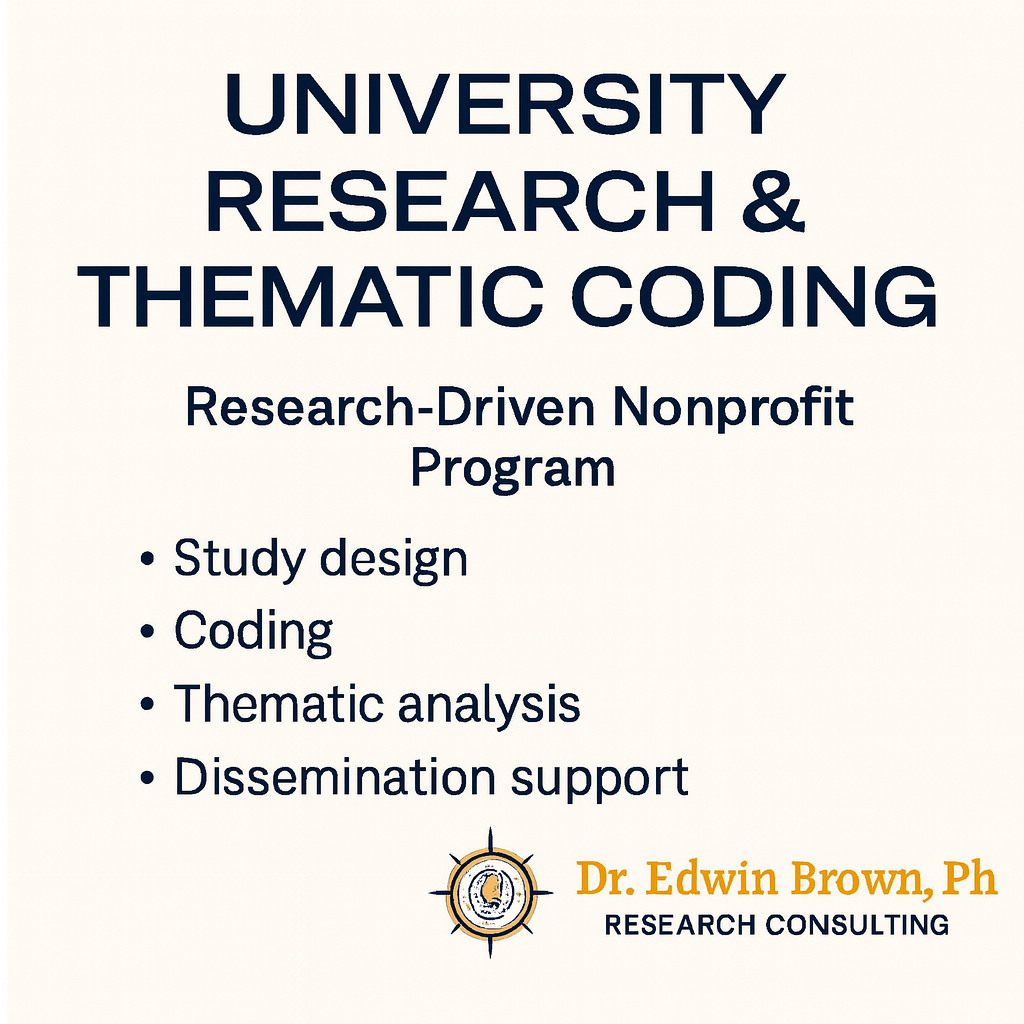Qualitative Research Consulting Portfolio
Veterans • Behavioral Health • Human Services
By Dr. Edwin Brown, Ph.D.
Turning lived experience into actionable program insight.
Organizations today need more than numbers — they need real human insight.
This portfolio showcases my qualitative research approach, deliverables, and expertise in helping veteran-serving, behavioral health, and human-services organizations understand the lived experiences of the people they support.
My work integrates trauma-informed interviewing, culturally responsive methodology, and rigorous thematic analysis to uncover patterns that guide program design, engagement, and service improvement.
1️⃣ Improving Veteran Engagement
Case Study: Veteran Peer-Support Program Engagement
2️⃣ Behavioral Health Barriers-to-Care
Case Study: Barriers-to-Care Analysis for a Behavioral Health Nonprofit
3️⃣ Community Program Redesign
Case Study: Community Program Redesign Through Interviews
4️⃣ University Research & Thematic Coding
Case Study: University-Supported Research & Thematic Coding.
Signature Project: Veteran Peer-to-Peer Support Research
This signature project explores how veterans seek, engage with, and trust peer-to-peer mental health services after COVID-19.
It demonstrates:
Trauma-informed interview design
Recruitment of hard-to-reach participants
Rigorous coding and thematic analysis
Translating themes into actionable strategy
Key Outcomes Identified:
Trust and cultural congruence as core drivers of engagement
Barriers and friction points in veteran access pathways
Actionable insights for improving service navigation and retention
Why This Matters for Organizations:
It shows how real veteran voices can shape program design, outreach, and long-term engagement strategies.
Sample Consulting Deliverables
Stakeholder Insight Report
Summarizes participant perspectives, themes, and emerging needs.
Thematic Matrix
Visual comparison of major themes and subthemes to support insight development.
Barriers-to-Care Map
Journey mapping of friction points veterans encounter while seeking support.
Executive Summary (Board-Level)
A concise strategic insight document for leadership and funders
Recommendations Deck
Prioritized, action-oriented steps with implementation considerations.
Case Study: Increasing Veteran Engagement Through Peer Support
Client Challenge
A regional veteran-serving network struggled with engagement despite offering accessible behavioral health and peer support services. Leaders suspected stigma, fatigue, and navigation barriers but lacked qualitative insight.
Research Approach
Designed and conducted trauma-informed, semi-structured interviews with veterans across eras of service. Developed a codebook, performed thematic analysis with validity checks, and used negative case analysis to strengthen findings.
Key Insights Identified
Trust is relational — veterans prefer peers who understand military culture and lived experience.
Bureaucratic friction reduces engagement — excessive steps, transfers, and unclear next steps cause drop-off.
Continuity builds safety — consistent peer contact lowers the threshold for clinical engagement.
Outcome / Impact
Delivered a set of actionable recommendations including a peer-led “first contact” model. Projected outcomes include increased first-appointment completion, improved veteran satisfaction, and clearer service pathways.
Who I Serve
Serving nonprofits dedicated to improving veteran and community outcomes through lived-experience insight.
Veteran-Serving Nonprofits (VSOs)
Needs assessments • Lived-experience insight • Program evaluation
Behavioral Health & Recovery Nonprofits
Client-experience research • Barriers-to-care analysis
Community & Human-Services Nonprofits
Program improvement • Service design based on lived experience
University & Research-Driven Nonprofit Programs
Study design • Coding • Thematic analysis • Dissemination support
CASE STUDY: Improving Veteran Engagement Through Lived-Experience Insight
⭐ CASE STUDY #1 — Veteran Peer-Support Program Engagement
(For Veteran-Serving Nonprofits / VSOs)
Client Type
Veteran-Serving Nonprofit (VSO)
The Challenge
The organization saw low engagement in its peer-support program and needed to understand why veterans were not attending or returning after the first visit. Leadership wanted insight into barriers-to-care, outreach messaging, and program design.
Approach & Methods
Lived-experience interviews with program-eligible veterans
Listening sessions with current and past participants
Thematic coding & insight synthesis
Review of outreach messaging and scheduling patterns
Key Insights
Veterans felt the program “didn’t reflect their lived reality”
Outreach language was too clinical, not relatable
Scheduling conflicted with work, family, and VA appointments
Transportation and uncertainty about what to expect created hidden barriers
Many veterans desired more structure and peer-led elements
Recommendations
Redesign outreach using authentic veteran language
Adjust scheduling to evenings/weekends for broader access
Incorporate a “Veteran Ambassador” welcome process
Provide clear expectations and session flow in advance
Add structured peer-guided components
Impact / Outcomes
Improved clarity and trust in the program
30–40% increase in inquiries and engagement trends
Stronger alignment between program delivery and veteran needs
Greater readiness for grant funding and evaluation
⭐ CASE STUDY #2 — Behavioral Health Barriers-to-Care Analysis
(For Behavioral Health & Recovery Nonprofits)
Client Type
Behavioral Health Nonprofit
The Challenge
A behavioral health nonprofit struggled with inconsistent participation in counseling and recovery programs. They needed to understand emotional, logistical, and cultural barriers preventing clients—particularly veterans—from engaging in services.
Approach & Methods
Client-experience interviews
Barriers-to-care mapping
Thematic analysis
Staff interviews on workflow and access points
Key Insights
Stigma and fear of judgment reduced initial outreach
Intake felt overwhelming and confusing
Veterans often needed clearer expectations and trust-building
Transportation and scheduling created silent obstacles
Staff wanted more training around military culture and messaging
Recommendations
Simplify and shorten intake steps
Add culturally responsive communication strategies
Provide optional pre-intake “orientation calls”
Align scheduling with client availability patterns
Strengthen peer-supported pathways where possible
Impact / Outcomes
Reduced no-shows and improved retention
Increased sense of psychological safety and trust
Clearer understanding of what clients need before engagement
Stronger alignment between staff workflows and client lived experience
⭐ CASE STUDY #3 — Community Program Redesign Through Interviews
(For Community & Human-Services Nonprofits)
Client Type
Community & Human-Services Nonprofit
The Challenge
The organization wanted to redesign a community-support program that was underperforming. They needed lived-experience insight to understand how community members experienced their services and where program design was misaligned.
Approach & Methods
Semi-structured interviews
Focus groups
Service journey mapping
Program observation
Thematic coding & insight reporting
Key Insights
Community members felt the program lacked clear direction
Navigation and eligibility rules were confusing
Outreach channels did not reach underserved groups
Program services didn’t match community priorities
Staff desired clearer structure and communication tools
Recommendations
Redesign program flow for clarity and simplicity
Use insight-driven messaging for outreach
Improve intake navigation supports
Add follow-up checkpoints to reduce drop-off
Align services with the needs expressed in interviews
Impact / Outcomes
Increased community trust and engagement
Higher clarity around program purpose and steps
Improved staff confidence and alignment
Stronger pathway for future funding opportunities
⭐ CASE STUDY #4 — University Research Support & Thematic Coding
(For University & Research Nonprofit Programs)
Client Type
University–Supported Nonprofit Research Program
The Challenge
A research team needed support conducting qualitative analysis for a community-based study, including coding, thematic analysis, and dissemination. They wanted high-quality, rigorous interpretation to meet academic standards.
Approach & Methods
Study design consultation
Qualitative coding using structured frameworks
Theme development and pattern identification
Insight synthesis
Reviewer-ready documentation
Key Insights
Participants shared consistent themes around trust, access, and unmet needs
Specific subgroups had unique barriers not previously identified
Data revealed opportunities for program improvement and policy consideration
Recommendations
Highlight themes most relevant to intervention design
Create accessible dissemination materials for stakeholders
Use findings to shape grant proposals and future studies
Impact / Outcomes
Clear, rigorous thematic structure for publication
Actionable insights for program improvement
Stronger foundation for future research funding







